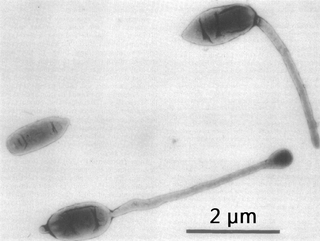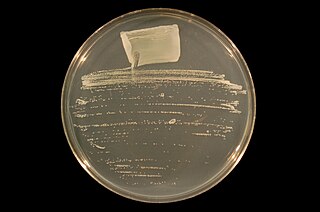
Pseudomonadota is a major phylum of Gram-negative bacteria. The renaming of several prokaryote phyla in 2021, including Pseudomonadota, remains controversial among microbiologists, many of whom continue to use the earlier name Proteobacteria, of long standing in the literature. The phylum Proteobacteria includes a wide variety of pathogenic genera, such as Escherichia, Salmonella, Vibrio, Yersinia, Legionella, and many others. Others are free-living (non-parasitic) and include many of the bacteria responsible for nitrogen fixation.

Rhizobium is a genus of Gram-negative soil bacteria that fix nitrogen. Rhizobium species form an endosymbiotic nitrogen-fixing association with roots of (primarily) legumes and other flowering plants.

Agrobacterium is a genus of Gram-negative bacteria established by H. J. Conn that uses horizontal gene transfer to cause tumors in plants. Agrobacterium tumefaciens is the most commonly studied species in this genus. Agrobacterium is well known for its ability to transfer DNA between itself and plants, and for this reason it has become an important tool for genetic engineering.

Ensifer meliloti are an aerobic, Gram-negative, and diazotrophic species of bacteria. S. meliloti are motile and possess a cluster of peritrichous flagella. S. meliloti fix atmospheric nitrogen into ammonia for their legume symbionts, such as alfalfa. S. meliloti forms a symbiotic relationship with legumes from the genera Medicago, Melilotus and Trigonella, including the model legume Medicago truncatula. This symbiosis promotes the development of a plant organ, termed a root nodule. Because soil often contains a limited amount of nitrogen for plant use, the symbiotic relationship between S. meliloti and their legume hosts has agricultural applications. These techniques reduce the need for inorganic nitrogenous fertilizers.

The Hyphomicrobiaceae are a family of bacteria. Among others, they include Rhodomicrobium, a genus of purple bacteria.

Frankia is a genus of nitrogen-fixing bacteria that live in symbiosis with actinorhizal plants, similar to the Rhizobium bacteria found in the root nodules of legumes in the family Fabaceae. Frankia also initiate the forming of root nodules.

Bradyrhizobium is a genus of Gram-negative soil bacteria, many of which fix nitrogen. Nitrogen fixation is an important part of the nitrogen cycle. Plants cannot use atmospheric nitrogen (N2); they must use nitrogen compounds such as nitrates.

Ensifer is a genus of nitrogen-fixing bacteria (rhizobia), three of which have been sequenced.
Neorhizobium galegae is a Gram negative root nodule bacteria. It forms nitrogen-fixing root nodules on legumes in the genus Galega.
Pararhizobium giardinii is a Gram negative root nodule bacteria. It forms nitrogen-fixing root nodules on legumes, being first isolated from those of Phaseolus vulgaris.
Neorhizobium huautlense is a Gram negative root nodule bacterium. It forms nitrogen-fixing root nodules on Sesbania herbacea.
Devosia neptuniae is a nitrogen-fixing bacteria that nodulates Neptunia natans. It is Gram-negative, strictly aerobic short rod-shaped and motile by a subpolar flagellum. The type strain of D. neptuniae is LMG 21357T.
Allorhizobium vitis is a plant pathogen that infects grapevines. The species is best known for causing a tumor known as crown gall disease. One of the virulent strains, A. vitis S4, is responsible both for crown gall on grapevines and for inducing a hypersensitive response in other plant species. Grapevines that have been affected by crown gall disease produce fewer grapes than unaffected plants. Though not all strains of A. vitis are tumorigenic, most strains can damage plant hosts.
Pararhizobium capsulatum is a bacterium from the genus Pararhizobium which was isolated from eutrophic forest pond in Germany.
Neorhizobium is a genus of Gram-negative soil bacteria that fix nitrogen. It was recently segregated from the genus Rhizobium. Neorhizobium forms an endosymbiotic nitrogen-fixing association with roots of legumes.
Allorhizobium is a genus of Gram-negative soil bacteria. Some species of Allorhizobium form an endosymbiotic nitrogen-fixing association with roots of legumes, while others are known to cause crown gall.
Paraburkholderia is a genus of Pseudomonadota that are gram negative, slightly curved rods that are motile by means of flagella. They have been reported to colonize endophytic tissues of hybrid spruce and lodgepole pine with a strong potential to perform biological nitrogen fixation and plant growth promotion. Unlike Burkholderia species, Paraburkholderia members are not commonly associated with human infection. Paraburkholderia members form a monophyletic clade within the Burkholderiaceae family, which is what prompted their distinction as a genus independent from Burkholderia species, in combination with the finding of robust conserved signature indels which are unique to Paraburkholderia species, and are lacking in members of the genus Burkholderia. These CSIs distinguish the genus from all other bacteria. Additionally, the CSIs that were found to be shared by Burkholderia species are absent in Paraburkholderia, providing evidence of separate lineages.
Peteryoungia aggregata is a gram-negative bacterium of the genus Peteryoungia.
The Rhodothermales are an order of bacteria.
Balneolales is an order of bacteria.







